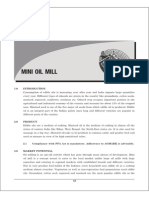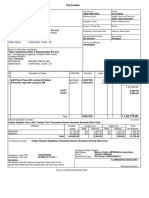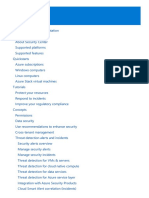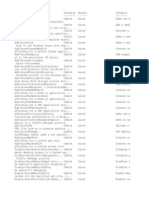Papad MFG
Papad MFG
Uploaded by
Farhat DurraniCopyright:
Available Formats
Papad MFG
Papad MFG
Uploaded by
Farhat DurraniOriginal Title
Copyright
Available Formats
Share this document
Did you find this document useful?
Is this content inappropriate?
Copyright:
Available Formats
Papad MFG
Papad MFG
Uploaded by
Farhat DurraniCopyright:
Available Formats
PAPAD MANUFACTURING
1.0 INTRODUCTION Papad is a popular and tasty food item in the Indian diet since many centuries. It is essentially a wafer-like product, round in shape and made from dough of powdered pulses, spices, powdered chilly and salt. Variety of pulses and proportion of pulses and spices varies from region to region depending upon preferences of local people whereas certain varieties are popular on a larger scale. Traditionally this activity was confined to household papad making but in view of increasing demand and availability of machinery (mechanisation) it has now been developed in cottage and small scale sector. 2.0 PRODUCT 2.1 Applications Papad is a favourite item with Indians and is used as taste enricher with the main course and as a snack item. Since it is made from pulses, it is easy to digest and nutritious as well. It is very easy to make instant food item and is either fried in edible oil or simply roasted before serving. Its shelf life is 2 to 3 months. This product can be made anywhere in the country. The note envisages location at an appropriate place in Assam. 2.2 Availability of technology, quality standard and compliances
CFTRI, Mysore, has successfully developed papad press. Compliance with PFA Act is mandatory. Quality standards as specified by BIS are available vide IS 2639:1984 3.0 MARKET POTENTIAL Market for papad is steadily growing across the country. There are not much seasonal fluctuations but demand generally goes up by 10% to 15% during winter season. There are a couple of national brands but the market is predominantly controlled by the local brands.
63
This activity is yet to pick up in Assam and thus prospects for a new entrant are bright, provided quality is good and prices are competitive. It can be sold through many outlets of provision and departmental stores. Before launching the product, a quick assessment of consumer preferences is advisable. 4.0 MANUFACTURING PROCESS Papad can be manufactured from different varieties of pulses or there could be a combination of pulses as well. Adequate quantity of water is added in flour of pulses, common salt, spices and sodium bicarbonate and homogenous mixing is done to obtain dough. After about 30 minutes, small balls weighing around 7-8 grams of dough are made. These balls are then placed in papad making machine or papad press wherein these balls are pressed and circular papads are made as per the size of mould. These papads are then sun-dried but in this note drier with trolley is recommended as sun-drying may not be always feasible in Assam. Lot of 25 or 50 papads is then packed in polythene bags. CFTRI, Mysore, has successfully developed papad making press. 5.0 CAPITAL INPUTS 5.1 Land and Building A plot of land of about 150 sq.mtrs. with built-up area of approximately 80 sq.mtrs. shall be adequate to house all the equipments leaving sufficient space for storage and packing. The location need not be at a prominent place as counter sales is not envisaged. The total cost of land is taken at Rs. 50,000 whereas the construction cost is assumed to be Rs.2.00 lacs. 5.2 Plant and Machinery It is suggested to have annual rated production capacity with 300 working days and 2 shift working of 60 tonnes. To install this capacity, following machinery shall be needed: Item Grinder with electric motor having 30-35 kgs/hr. capacity Mixer of 20 kgs. per charge capacity with electric motor Pedal-operated papad press Drier with trolley and 48 trays with heating element of 9 KW Extra aluminium trays Sealing Machine Water Storage tank Laboratory Equipments Weighing Scale Qty. 1 1 2 1 50 2 1 -1 Total 5.3 Miscellaneous Assets Price (Rs.) 22,000 20,000 14,000 50,000 5,000 4,000 5,000 5,000 7,000 1,32,000
Some other assets like aluminium top tables, furniture & fixtures, baskets, drums, storage racks, aluminium/stainless steel utensils etc. shall also be required for which a provision of Rs. 40,000/- is made.
64
5.4
Utilities
The total power requirement shall be 25 HP whereas water required for process and sanitation and other purposes shall be about 700-750 ltrs per day. The annual cost under this head at 100% capacity utilisation shall be around Rs. 50,000/-. 5.5 Raw Material
The all important raw material would be flour of pulses depending upon the product mix. Since annual requirement even at 100% will not be more than 60 tonnes, availability would not be a bottleneck. Other materials like salt, spices, edible oil, preservatives etc. shall be required in small quantity and they will be available locally. Packing material like different sizes of polythene bags and corrugated boxes shall also be available locally. 6.0 MANPOWER REQUIREMENTS Particulars Skilled Workers Helpers Salesman Nos. 2 4 1 Monthly Salary (Rs.) 1,800 1,200 2,000 Total Total Monthly Salary (Rs.) 3,600 4,800 2,000 10,400
7.0
TENTATIVE IMPLEMENTATION SCHEDULE Activity Application and sanction of loan Site selection and commencement of civil work Completion of civil work and placement of orders for machinery Erection, installation and trial runs Period (in months) 2 1 4 1
8.0
DETAILS OF THE PROPOSED PROJECT 8.1 Item Land Building Land and Building Area (Sq.Mtrs) 160 80 Total 8.2 Machinery Cost (Rs.) 50,000 2,00,000 2,50,000
The total cost as spelt out earlier will be Rs. 1, 32,000/-. 8.3 Miscellaneous Assets
A provision of Rs. 40,000 as explained before is considered to be sufficient.
65
8.4
Preliminary & Pre-operative Expenses
Expenses like registration & establishment charges, trial run, interest during project implementation etc. will be around Rs.40,000/-. 8.5 Working Capital Requirement
The rated production capacity of the project shall be 60 tonnes per year but it is assumed that it would operate at 60% in the first year. The working capital needs at this level shall be as under: (Rs. in lacs) Particulars Stock of Raw Materials Stock of Finished Goods Receivables Other Expenses Period Month Month 1 Month 1 Month Margin 30% 25% 25% 100% Total 8.6 Cost of the Project and Means of Financing Item Land and Building Machinery Miscellaneous Assets P&P Expenses Contingencies @ 10% on Building and Plant & Machinery Working Capital Margin Total Means of Finance Promoters' Contribution Term Loan from Bank/FI Total Debt Equity Ratio Promoters' Contribution 1.75 3.85 5.60 2.20 : 1 31% Total 0.28 0.40 0.90 0.20 1.78 Bank 0.20 0.30 0.68 -1.18 Promoters 0.08 0.10 0.22 0.20 0.60
(Rs. in lacs) Amount 2.50 1.32 0.40 0.40 0.38 0.60 5.60
Financial assistance in the form of grant is available from the Ministry of Food Processing Industries, Govt. of India, towards expenditure on technical civil works and plant and machinery for eligible projects subject to certain terms and conditions.
66
9.0
PROFITABILITY CALCULATIONS 9.1 Production Capacity and Build-up The annual installed capacity shall be 60 tonnes but in view of teething troubles and other difficulties like power failure, absenteeism etc. the actual utilisation is taken at 60% and 75% respectively during first 2 years. 9.2 Sales Revenue at 100% Qty. (Tonnes) 60 Selling Price (Rs.) 32,000 (Rs. in lacs) Sales 19.20
Product Papad
9.3
Raw Materials Required at 100% Qty. (Tonnes) 58 Rate per Ton 16,000
(Rs. in lacs) Value 9.28
Product Flour of Pulses Edible Oil, Salt, Spices, Preservatives, etc. Packing Material
---
--Total
0.60 0.70 10.58
9.4
Utilities
Annual expenditure on utilities even at 100% activity level is likely to be Rs. 50,000/- as explained earlier. 9.5 Interest
Interest on term loan of Rs. 3.85 lacs is calculated @ 12% per annum considering a moratorium period of 1 year and then repayment in 3 years. Interest on working capital assistance from bank is taken at 14% per annum. 9.6 Depreciation
The method adopted is WDV and rates considered are 10% on building and 20% on plant & machinery and miscellaneous assets.
67
10.0
PROJECTED PROFITABILITY (Rs. in lacs) No. A Particulars Installed Capacity Capacity Utilisation Sales Realisation B Cost of Production Raw Materials Utilities Salaries Stores & Spares Repairs & Maintenance Selling Expenses @ 10% Administrative Expenses Total C Profit before Interest & Depreciation Interest on Term Loan Interest on Working Capital Depreciation Net Profit Income-tax @ 20% Profit after Tax Cash Accruals Repayment of Term Loan 6.34 0.30 1.25 0.15 0.18 1.15 0.18 9.55 1.97 0.43 0.17 0.59 0.78 -0.78 1.37 -7.93 0.38 1.40 0.18 0.24 1.44 0.24 11.81 2.59 0.29 0.21 0.50 1.59 0.30 1.29 1.79 1.20 1st Year 60% 11.52 2nd Year 75% 14.40 ---- 60 Tonnes -----
11.0
BREAK-EVEN ANALYSIS No [A] [B] Particulars Sales Variable Costs Raw Materials Utilities (70%) Salaries (70%) Stores & Spares Selling Expenses (80%) Admn. Expenses (50%) Interest on WC [C] [D] [E] Contribution [A] - [B] Fixed Costs Break-Even Point [D] [C] 7.93 0.28 0.98 0.18 1.01 0.12 0.21
(Rs. in lacs) Amount 14.40
10.71 3.69 2.10 57%
68
12.0
[A]
LEVERAGES Financial Leverage = EBIT/EBT = 1.38 0.78 = 1.77
Operating Leverage = Contribution/EBT = 2.79 0.78 = 3.56
Degree of Total Leverage = FL/OL = 1.77 3.56 = 0.50
[B]
Debt Service Coverage Ratio (DSCR) (Rs. in lacs)
Particulars Cash Accruals Interest on TL Total [A] Interest on TL Repayment of TL Total [B] DSCR [A] [B] Average DSCR
1st Yr 1.37 0.43 1.80 0.43 -0.43 4.19
2nd Yr 1.79 0.29 2.08 0.29 1.30 1.59 1.31
3rd Yr 1.99 0.18 2.17 0.18 1.30 1.48 1.47
4th Yr 2.24 0.07 2.31 0.07 1.25 1.32 1.75
---------------------------- 2.18--------------------------
69
[C]
Internal Rate of Return (IRR)
Cost of the project is Rs. 5.60 lacs. (Rs. in lacs) Year 1 2 3 4 5 Cash Accruals 1.37 1.79 1.99 2.24 2.47 9.86 16% 1.18 1.33 1.28 1.24 1.18 6.21 18% 1.16 1.29 1.21 1.16 1.08 5.90 20% 1.14 1.24 1.15 1.08 0.99 5.60 24% 1.10 1.16 1.04 0.95 0.84 5.09
The IRR is around 20%.
The machinery suppliers in Guwahati are 1. 2. Industrial Equipments Archana Machinery Stores
70
You might also like
- Oil MillDocument8 pagesOil Millmanish.eer2394No ratings yet
- Profile For Coir Fiber or Dust Moulding UnitDocument7 pagesProfile For Coir Fiber or Dust Moulding UnitAnandh SharavanNo ratings yet
- Profile For Coir Fibre Extraction UnitDocument6 pagesProfile For Coir Fibre Extraction Unitalican akinNo ratings yet
- Project Profile For Coir Geo Textiles Automatic Loom UnitDocument5 pagesProject Profile For Coir Geo Textiles Automatic Loom UnitathulkmmanikyanNo ratings yet
- Project Profile For Coir Handicraft or Ornaments Production UnitDocument5 pagesProject Profile For Coir Handicraft or Ornaments Production Unitarka giftsNo ratings yet
- Project Profile For Semi Automatic Coir Matting UnitDocument5 pagesProject Profile For Semi Automatic Coir Matting UnitMurugesNo ratings yet
- Project Profile For Coir Pith Block Making UnitDocument6 pagesProject Profile For Coir Pith Block Making UnitRishabh BalaniNo ratings yet
- Project Report: IT & IT Enabled UnitDocument34 pagesProject Report: IT & IT Enabled UnitRishabh BalaniNo ratings yet
- Recycling of Pet (Pet Plakes)Document10 pagesRecycling of Pet (Pet Plakes)Shaik BashaNo ratings yet
- Project Profile For Coir Pith Briquette Unit: - IntroductionDocument6 pagesProject Profile For Coir Pith Briquette Unit: - IntroductionSatish SatiNo ratings yet
- Potato ProductsDocument8 pagesPotato ProductsMedha TyagiNo ratings yet
- Coco Peat Machine ManufacturersDocument8 pagesCoco Peat Machine ManufacturersRajarathinamNo ratings yet
- Project Profile For Coir Paper or Paper Products Making UnitDocument6 pagesProject Profile For Coir Paper or Paper Products Making Unitavinash sainiNo ratings yet
- Ultratech Cement Invoice 2023-24-0008Document1 pageUltratech Cement Invoice 2023-24-0008viswanathNo ratings yet
- Coconut Products: 1.0 Product and Its ApplicationsDocument6 pagesCoconut Products: 1.0 Product and Its ApplicationsAgri NetNo ratings yet
- Milk Production in Dry Zone - Sunil GamageDocument8 pagesMilk Production in Dry Zone - Sunil GamageSunil GamageNo ratings yet
- Project Report For Biomass BriquettingDocument73 pagesProject Report For Biomass BriquettingPrakhar Sharma0% (1)
- Tax Invoice: SEN/CBE/0007 9-Jul-2022 100% Adv PaymentDocument1 pageTax Invoice: SEN/CBE/0007 9-Jul-2022 100% Adv PaymentMPM SENTHILNo ratings yet
- Project Profile On Groundnut Oil and Oil Cake ManuafcuringDocument2 pagesProject Profile On Groundnut Oil and Oil Cake ManuafcuringprtmNo ratings yet
- Azure Docu PDFDocument349 pagesAzure Docu PDFJerome Macaraig TolentinoNo ratings yet
- EcoBrick A Waste Plastic Used As Construction MaterialDocument6 pagesEcoBrick A Waste Plastic Used As Construction MaterialIJRASETPublicationsNo ratings yet
- Bhagavaduttara GitaamruthamDocument222 pagesBhagavaduttara GitaamruthamMOHAN PUBLICATIONS - DEVULLU.COM - TELUGU BOOKS - BHAKTI BOOKS - Devullu.comNo ratings yet
- Azure Powershell CmdletsDocument9 pagesAzure Powershell CmdletsSunil KatkeNo ratings yet
- Ashadullah Shawon CV DevOps EngineerDocument3 pagesAshadullah Shawon CV DevOps EngineershawonNo ratings yet
- How To Produce Milk - Supply Chain ManagementDocument6 pagesHow To Produce Milk - Supply Chain ManagementEka DarmadiNo ratings yet
- 2019 ACTINI Egg Processing EN Réduit PDFDocument8 pages2019 ACTINI Egg Processing EN Réduit PDFKimani MungaiNo ratings yet
- Project Profile On Kurkure Type Snacks PDFDocument2 pagesProject Profile On Kurkure Type Snacks PDFSundeep Yadav100% (4)
- Ovostar Egg ProductsDocument20 pagesOvostar Egg ProductsPatricia de LeonNo ratings yet
- Green Chilies - Business PlanDocument19 pagesGreen Chilies - Business PlanAdarsh Agrawal100% (1)
- Coir Pith Block Making UnitDocument3 pagesCoir Pith Block Making UnitMohan RajNo ratings yet
- Backup, Restore, and Recovery For Windows Server 2003 and Active DirectoryDocument24 pagesBackup, Restore, and Recovery For Windows Server 2003 and Active Directoryapi-3729555100% (1)
- On MakhanaDocument29 pagesOn MakhanaAbhishek Gunawat0% (1)
- Milk Handling and HygieneDocument48 pagesMilk Handling and HygieneRaja GunalanNo ratings yet
- h17576 Ecs Commvault Config Guide Best Practices WPDocument32 pagesh17576 Ecs Commvault Config Guide Best Practices WPMuthu LakshmananNo ratings yet
- పూజ హోమ కల్పతరువుDocument442 pagesపూజ హోమ కల్పతరువుSAI MAHESH MAHESHNo ratings yet
- Patch Management Slides For Lab Tutorials - V4Document65 pagesPatch Management Slides For Lab Tutorials - V4Carlos RamosNo ratings yet
- KodekloudDocument1 pageKodekloudsaqlain saleemNo ratings yet
- Project Report: Beema ScrapDocument6 pagesProject Report: Beema ScrapV S VIJITHNo ratings yet
- Java - Download and Install JDK 10 On Windows PDFDocument16 pagesJava - Download and Install JDK 10 On Windows PDFMmaNo ratings yet
- Docklight ManualDocument55 pagesDocklight ManualHector Ivan Urzua VargasNo ratings yet
- SVERI DevOps LabDocument49 pagesSVERI DevOps LabBennish MNo ratings yet
- Launching An EKS ClusterDocument6 pagesLaunching An EKS Clusterhamza moussirNo ratings yet
- DPR - Mineral Water PlantDocument9 pagesDPR - Mineral Water PlantVijay Anand S Grdcs CSNo ratings yet
- Azure COntainer Registry 01.2022Document486 pagesAzure COntainer Registry 01.2022Wall GreenNo ratings yet
- Reduce EBiz Upgrade Downtime 1540446877131001vacx PDFDocument89 pagesReduce EBiz Upgrade Downtime 1540446877131001vacx PDFMohammed AyaazNo ratings yet
- Ebook Schemes Ministry of Food Processing Industries Lyst8437Document8 pagesEbook Schemes Ministry of Food Processing Industries Lyst8437exp expoNo ratings yet
- KuburnetsDocument67 pagesKuburnetsonubeyNo ratings yet
- Alfresco Community Edition 3 3 Windows Simple InstallDocument2 pagesAlfresco Community Edition 3 3 Windows Simple Installtylerclark50No ratings yet
- 19 EKS-ClusterDocument11 pages19 EKS-ClusterPankaj KumarNo ratings yet
- Agent Installation & Configuration Guide For BCA-C06Document10 pagesAgent Installation & Configuration Guide For BCA-C06Đoàn DựNo ratings yet
- Load-Balancing & Auto Scaling On AwsDocument20 pagesLoad-Balancing & Auto Scaling On AwsSARANG RNo ratings yet
- Lab 04 - Implement Virtual NetworkingDocument8 pagesLab 04 - Implement Virtual NetworkingMoussa YasbahNo ratings yet
- Azure Fundamentals Learning Path (July 2019)Document1 pageAzure Fundamentals Learning Path (July 2019)talenta mipaNo ratings yet
- Red Hat OpenShift The Ultimate Step-By-Step GuideFrom EverandRed Hat OpenShift The Ultimate Step-By-Step GuideRating: 1 out of 5 stars1/5 (1)
- 11 PohaDocument8 pages11 PohapritamrbhadadeNo ratings yet
- Biscuit MakingDocument8 pagesBiscuit Makingkmsalim007No ratings yet
- Soya SauceDocument8 pagesSoya Sauceizaru24No ratings yet
- Maize PpopcornDocument7 pagesMaize PpopcornFarhat DurraniNo ratings yet
- Desiccated CoconutDocument8 pagesDesiccated CoconutYohanes Slamet WidodoNo ratings yet
- Fruit SquashDocument9 pagesFruit SquashGanesh DarsipudiNo ratings yet
- Intensive Moringa Oleifera Cultivation in The North of SenegalDocument7 pagesIntensive Moringa Oleifera Cultivation in The North of SenegalFarhat DurraniNo ratings yet
- Moringa Cultivation and Its UsesDocument16 pagesMoringa Cultivation and Its UsesFarhat Durrani100% (1)
- Manual NurseryDocument133 pagesManual NurseryFarhat DurraniNo ratings yet
- Concept Paper Proforma For PCDocument1 pageConcept Paper Proforma For PCFarhat DurraniNo ratings yet
- BiotechnologyDocument322 pagesBiotechnologyimtiazali2008100% (1)
- Moringa: A Botanical PharmacopoeiaDocument4 pagesMoringa: A Botanical PharmacopoeiaFarhat DurraniNo ratings yet
- International Workshop On Moringa and Nutrition: Accra, Ghana November 16-18, 2006Document37 pagesInternational Workshop On Moringa and Nutrition: Accra, Ghana November 16-18, 2006Farhat DurraniNo ratings yet
- Salient FeaturesDocument156 pagesSalient FeaturesmiqbalmkNo ratings yet
- 2716 Classification of Crops On Basis of AgronomyDocument2 pages2716 Classification of Crops On Basis of AgronomyFarhat DurraniNo ratings yet
- Jowar FlakesDocument8 pagesJowar FlakesAmit JainNo ratings yet
- Maize PpopcornDocument7 pagesMaize PpopcornFarhat DurraniNo ratings yet
- Milled Maize ProductDocument7 pagesMilled Maize ProductFarhat DurraniNo ratings yet
- PC1 Edible Oil FinalDocument37 pagesPC1 Edible Oil FinalFarhat DurraniNo ratings yet
- Maize FlakesDocument8 pagesMaize FlakesFarhat DurraniNo ratings yet
- 10 Pigeon Pea ProcessingDocument8 pages10 Pigeon Pea ProcessingPaneendra KumarNo ratings yet
- Rice FlakesDocument9 pagesRice FlakesAkhil PittyNo ratings yet
- Wazaiful AbrarDocument433 pagesWazaiful Abrarwassi1214100% (1)











































































